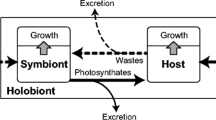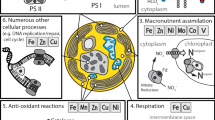Abstract
The temperate sea anemone Anemonia viridis (Forskål) forms an endosymbiotic association with dinoflagellate algae commonly referred to as zooxanthellae. It is now well established that under appropriate environmental conditions, these associations can be autotrophic for carbon. Under such conditions, many of these symbioses, including A. viridis, not only retain excretory ammonium, but can take up ammonium added to the surrounding seawater. The flux from inorganic to organic nitrogen will be via the free amino acid pools and in A. viridis these were found to be markedly different between zooxanthellae and host with glycine and taurine dominant in the latter. When anemones were maintained with 20 μM ammonium, the concentration of free amino groups increased in the zooxanthellae but appeared not to change in the host. There was no evidence that the ratio of glutamine – glutamate in zooxanthellae changed when anemones were maintained with 20 μM ammonium for 47 days. These ratios imply that zooxanthellae from this temperate symbiosis may not be nitrogen-limited. GDH was detected in both zooxanthellae and host where it was most active with the coenzyme NADPH. In addition, GDH showed activity when glutamine replaced ammonium as the substrate, indicating that the host may have alternative means to assimilate ammonium. Zooxanthellae were shown to possess GOGAT activity in the presence of a ferredoxin analogue. This suggests that in vivo zooxanthellae could assimilate ammonium via the activity of GS linked with ferredoxin-dependent GOGAT. Given evidence from other studies of rapid ammonium assimilation and essential amino acid synthesis in symbiotic host tissue, it appears that the capacity of cnidarians to metabolise nitrogen may at present be underestimated.
Similar content being viewed by others
REFERENCES
Ahmed, I. & J. A. Hellebust, 1988. Enzymology of ammonium assimilation in three green flagellates. New Phytol. 109: 415–421.
Anderson, S. L. & J. E. Burris, 1987. Role of glutamate synthetase in ammonia assimilation by symbiotic marine dinoflagellates (zooxanthellae). Mar. Biol. 94: 451–458.
Bishop, S. H., A. Klotz, L. L. Drolet, D. H. Smullin & R. J. Hoffman, 1978. NADP-specific glutamate dehydrogenase in Metridium senile (L.). Comp. Biochem. Physiol. 61(B): 185–187.
Bradford, M. M., 1976. A rapid and sensitive method for the quantitation of microgram quantities of protein utilising the principle of protein-dye binding. Anal. Biochem. 72: 248–254.
Burris, R. H., 1983. Uptake and assimilation of 15NH4 + by a variety of corals. Mar. Biol. 75: 151–155.
Cates, N. & J. J. A. McLaughlin, 1976. Differences of ammonia metabolism in symbiotic and aposymbiotic Condylactus and Cassiopea spp. J. exp. mar. Biol. Ecol. 21: 1–5.
Catmull, J., D. Yellowlees & D. J. Miller (1987). NADP+-dependent glutamate dehydrogenase from Acropora formosa: purification and properties. Mar. Biol. 95: 559–563.
Crossland, C. J. & D. J. Barnes, 1977. Nitrate assimilation enzymes from two hard corals, Acropora acuminata and Goniastrea australensis. Comp. Biochem. Physiol. 57B: 151–157.
Davies, P. Spencer, 1992. Endosymbiosis in marine cnidarians. In John, D. M., S. J. Hawkins & J. H. Price, (eds), Plant—Animal Interactions in the Marine Benthos. Clarendon Press, Oxford: 511–540.
Davy S. K., I. A. N. Lucas & J. R. Turner, 1996. Carbon budgets in temperate anthozoan-dinoflagellate symbioses. Mar. Biol. 126: 773–783.
Davy S. K., J. R. Turner & I. A. N. Lucas, 1997. The nature of temperate anthozoan-dinoflagellate symbiosis. In Lessios, H. A., I. G. Macintyre & M. McGee (eds), Proc. 8th Int. Coral Reef Sym. Smithsonian Tropical Research Institute, Balboa, Republic of Panamá: 1307–1312.
Deaton, L. E. & R. J. Hoffman, 1988. Hypoosmotic volume regulation in the sea anemone Metridium senile. Comp. Biochem. Physiol. 91C: 187–191.
Dudler, N., D. Yellowlees & D. J. Miller, 1987. Localisation of two L-glutamate dehydrogenases in the coral Acropora latistella. Arch. Biochem. Biophys. 254: 368–371.
Dudler, N. & D. J. Miller, 1988. Characterisation of two glutamate dehydrogenases from the symbiotic microalga Symbiodinium microadriaticum isolated from the coral Acropora formosa. Mar. Biol. 97: 427–430.
Dunlap, W. C. & B. E. Chalker, 1986. Identification and quantitation of near-UV absorbing compounds (S-320) in a hermatypic scleractinian. Coral Reefs 5: 155–159.
FitzGerald, L.M. & A. M. Szmant, 1997. Biosynthesis of ‘essential’ amino acids by scleractinian corals. Biochem. J. 322: 213–221.
Flynn, K. J., 1990. The determination of nitrogen status in microalgae. Mar. Ecol. Prog. Ser. 61: 297–307.
Flynn, K. J., 1991. Algal carbon—nitrogen metabolism: a biochemical basis for modelling the interactions between nitrate and ammmonium uptake. J. Plankton Res. 13: 373–387.
Fowden, L., 1981. Contrasts in nitrogen metabolism between animals and plants. In Waterlow, J. C. & J. M. L. Stephen (eds), Nitrogen Metabolism in Man. Applied Science Publishers, London: 87–95.
Hecht, U., R. Oelmuller, S. Schmidt, & H. Mohr, 1988. Action of light, nitrate and ammonium on the levels of NADH-and ferredoxin-dependent glutamate synthases in the cotyledons of mustard seedlings. Planta 175: 130–138.
Herrera, F. C., I. Lopez, R. Egea & I. P. Zanders, 1989. Short-term osmotic responses of the cells and tissues of the sea anemone, Condylactis gigantea. Comp. Biochem. Physiol. 92A: 377–384.
Hochachka, P. W. & G. N. Somero, 1984. Biochemical Adaptation. Princeton University Press, Princeton, New Jersey: 537 pp.
Hoffman, R. J., S. H. Bishop & C. Sassaman, 1978. Glutamate dehydrogenase from coelenterates NADP specific. J. exp. Zool. 203: 165–170.
Jarret, H. W., K. D. Cooksy, B. Ellis & J. M. Anderson, 1985. The separation of o-phthalaldehyde derivatives of amino acids by reversed-phase chromatography on octylsilica columns. Anal. Biochem. 153: 189–198.
Kasschau, M. R., J. B. Ragland, S. O. Pinkerton & E. C. M. Chen, 1984. Time related changes in the free amino acid pool of the sea anemone Bunodosoma cavernata. Comp. Biochem. Physiol. 79A: 155–159.
Kawaguti, S., 1953. Ammonium metabolism of the reef corals. Biol. J. Okayama Univ. 1: 171–176.
Male, K. B. & K. B. Storey, 1983. Kinetic characterisation of NADP-specific glutamate dehydrogenase from the sea anemone, Anthopleura xanthogrammica: control of amino acid biosynthesis during osmotic stress. Comp. Biochem. Physiol. 76B: 823–829.
Manuel, R. L., 1981. British Anthozoa. Academic Press, London.
Matoh T., E. Takahashi & S. Ida, 1979. Glutamate synthase in developing pea cotyledons: occurrence of NADH-dependent and ferredoxin-dependent enzymes. Plant Cell Physiol. 20: 1455–1459.
McAuley, P. J., 1992. The effect of maltose release on growth and nitrogen limitation of symbiotic Chlorella. Br. Phycol. J. 27: 417–422.
McAuley, P. J., 1994. Amino acid content of zooxanthellae freshly isolated from Pocillopora damicornis. Pacific Sci. 48: 247–253.
McAuley, P. J. & C. B. Cook, 1994. Effects of host feeding and dissolved ammonium on cell division and nitrogen status of zooxanthellae in the hydroid Myrionema amboinense. Mar. Biol. 121: 343–348.
McIlwain, H. & H. S. Bachelard, 1971. Biochemistry and the Central Nervous System. Churchill Livingston, London: 616 pp.
Miflin, B. J. & P. J. Lea, 1977. Amino acid metabolism. Ann. Rev. Plant Physiol. 28: 299–329.
Miller, R. E. & E. R. Stadtman, 1972. Glutamate synthase from Escherichia coli. J. Biol. Chem. 247: 7407–7419.
Miller, D. J. & D. Yellowlees, 1989. Inorganic nitrogen uptake by symbiotic marine cnidarians: a critical review. Proc. r. Soc. Lond. B 237: 109–125.
Moore, S. & W. H. Stein, 1948. Photometric ninhydrin method for use in the chromatography of amino acids. J. Biol. Chem. 176: 367–388.
Muscatine, L. & C. F. D'Elia, 1978. The uptake, retention, and release of ammonium by reef corals. Limnol. Oceanogr. 23: 725–734.
Muscatine, L. & J. W. Porter 1977. Reef corals mutualistic symbioses adapted to nutrient-poor environments. BioScience 27: 454–460.
Muscatine, L., H. Masuda & R. Burnap, 1979. Ammonium uptake by symbiotic and aposymbiotic reef corals. Bull. mar. Sci. 29: 572–575.
Pierce, S. K., Jr. & L. L. Minasian, Jr., 1974. Water balance of a euryhaline sea anemone, Diadumene leucolena. Comp. Biochem. Physiol. 49A: 159–167.
Rahav, O., Z. Dubinsky, Y. Achituv & P. G. Falkowski, 1989. Ammonium metabolism in the zooxanthellate coral, Stylophora pistillata. Proc. r. Soc. Lond. B 236: 325–337.
Rees, T. A. V., 1987. The green hydra symbiosis and ammonium I. The role of the host in ammonium assimilation and its possible regulatory significance. Proc. r. Soc. Lond. B 229: 299–314.
Rees, T. A. V., 1989. The green hydra symbiosis and ammonium II. Ammonium assimilation and release by freshly isolated symbionts and cultured algae. Proc. r. Soc. Lond. B 235: 365–382.
Rees, T. A. V & F. M. Ellard, 1989. Nitrogen conservation and the green hydra symbiosis. Proc. r. Soc. Lond. B 236: 203–212.
Rees, T. A. V., W. K. Fitt & D. Yellowlees, 1994. Host glutamine synthetase activities in the giant clam-zooxanthellae symbiosis: effects of clam size, elevated ammonia and continuous darkness. Mar. Biol. 118: 681–685.
Roberts, J. M., P. S. Davies & L. M. Fixter, 1999a. Symbiotic anemones can grow when starved: nitrogen budget for Anemonia viridis in ammonium-supplemented seawater. Mar. Biol. 133: 29–35.
Roberts, J. M., P. S. Davies, L. M. Fixter & T. Preston, 1999b. Primary site and initial products of ammonium assimilation in the symbiotic sea anemone Anemonia viridis. Mar. Biol. 135: 223–236.
Shick, J. M., 1976. Ecological physiology and genetics of the colonizing actinian Haliplanella luciae. In Mackie, G. O. (ed.), Coelenterate Ecology and Behavior. Plenum, New York: 137–146.
Shick, J. M., 1991. A Functional Biology of Sea Anemones. Chapman & Hall, London: 395 pp.
Smith, E. L., B. M. Austen, K. M. Blumenthal & J. F. Nye, 1975. Glutamate dehydrogenases. In Boyer, P. D. (ed.), The Enzymes. Academic Press, New York. Vol 11: 293–367.
Stahl, E., 1965. Thin-layer Chromatography. A Laboratory Handbook. Academic Press, New York.
Summons, R. E., T. S. Boag & C. B. Osmond, 1986. The effect of ammonium on photosynthesis and the pathway of ammonium assimilation in Gymnodinium microadriaticum in vitro and in symbiosis with tridacnid clams and corals. Proc. r. Soc. Lond. B 227: 147–159.
Summons, R. E. & C. B. Osmond, 1981. Nitrogen assimilation in the symbiotic marine alga Gymnodinium microadriaticum: direct analysis of 15N incorporation by GC-MS methods. Phytochemistry 20: 575–578.
Swanson, R. & O. Hoegh-Guldberg, 1998. Amino acid synthesis in the symbiotic sea anemone Aiptasia pulchella. Mar. Biol. 131: 83–93.
Szmant-Froelich, A. & M. E. Q. Pilson, 1977. Nitrogen excretion by colonies of the temperate coral Astrangia danae with and without zooxanthellae. In Taylor, D. L. (ed.), Proc. 3rd International Coral Reef Symposium, Miami. Rosentiel School of Marine and Atmospheric Science, University of Miami, Miami: 1: 417–424.
Tytler, E. M. & P. Spencer Davies, 1986. The budget of photosynthetically derived energy in the Anemonia sulcata (Pennant) symbiosis. J. exp. mar. Biol. Ecol. 99: 257–269.
Urich, K., 1990. Comparative Animal Biochemistry. Springer Verlag, Berlin: 403–462.
Wang, J-T & A. E. Douglas, 1998. Nitrogen recycling or nitrogen conservation in an alga-invertebrate symbiosis? J. exp. Biol. 201: 2445–2453.
Wilkerson, F. P. & L. Muscatine, 1984. Uptake and assimilation of dissolved inorganic nitrogen by a symbiotic sea anemone. Proc. r. Soc. Lond. B 221: 71–86.
Wilkerson, F. P. & R. K. Trench, 1986. Uptake of dissolved inorganic nitrogen by the symbiotic clam Tridacna gigas and the coral Acropora sp. Mar. Biol. 93: 237–246.
Yellowlees, D., T. A. V. Rees & W. K. Fitt, 1994. Effect of ammonium-supplemented seawater on glutamine synthetase and glutamate dehydrogenase activities in host tissue and zooxanthellae of Pocillopora damicornis and on ammonium uptake rates of the zooxanthellae. Pacific Sci. 48: 291–295.
Author information
Authors and Affiliations
Rights and permissions
About this article
Cite this article
Roberts, J.M., Fixter, L.M. & Davies, P.S. Ammonium metabolism in the symbiotic sea anemone Anemonia viridis. Hydrobiologia 461, 25–35 (2001). https://doi.org/10.1023/A:1012752828587
Issue Date:
DOI: https://doi.org/10.1023/A:1012752828587




